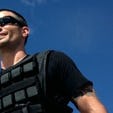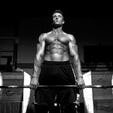Summer is quickly approaching with professional athletes and novice gym-goers alike facing the challenge of exercising in the heat. Extreme temperatures can cause dehydration, heat exhaustion, and decreased performance. The fact is, you’re not going to be able to stay cool during your workout (you’re going to get hot no matter what), but you can stay “cool” in the sense that you can increase your capacity to hang with the heat and keep performing.
In part one of this article I discussed the four thermogenic mechanisms within the human body and how those are used to cool down your internal temperature. Now, let’s look at how we can develop some strategies to build up your tolerance to heat.
Beating the Heat with Heat Acclimation
Heat acclimation is the process in which the body is gradually exposed to higher temperatures. Slowly exposing the body to an extreme climate each day will help you acclimate to the heat leading to increased workout performance.
Begin by spending a few minutes outdoors each day performing some form of physical activity, preferably in the afternoon when temperatures are highest. Choosing the shade over direct sun exposure is an excellent idea when first beginning a heat acclimation journey. Use the following as a basic guide to get started.
Beginner Heat Acclimation Bodyweight Workout Program
| Shaded Heat Acclimation Workout Time (min) | Sun Exposure Heat Acclimation Workout Time (min) | |
| Day 1 | 5 | 0 |
| Day 2 | 10 | 0 |
| Day 3 | 15 | 0 |
| Day 4 | 20 | 0 |
| Day 5 | 25 | 0 |
| Day 6 | 30 | 0 |
| Day 7 | 35 | 0 |
| Day 8 | 35 | 5 |
| Day 9 | 30 | 10 |
| Day 10 | 25 | 15 |
| Day 11 | 20 | 20 |
| Day 12 | 15 | 25 |
| Day 13 | 10 | 30 |
| Day 14 | 5 | 35 |
Perform each of the following movements in a circuit fashion for the given day’s time frame. Complete 10 reps of each movement in as many rounds of the following as possible: push-up to knee, push-up, body weight plank, jump squat, and deck squat. If you cannot perform the deck squat, perform alternating lunges. Hold the plank for 30 seconds before moving onto the next movement.
As with any program, especially one that includes exercises in hot conditions, make sure to stay well hydrated. Always arrange a consultation with your physician before beginning any new training regimen.
Beating the Heat with Sodium Manipulation
Advanced athletes who experience prolonged heat exposure develop a cooling mechanism which increases sweat production. Athletes performing high intensity movements interspersed with rest produce more sweat than jogging alone.
This increase in perspiration leads to lower levels of electrolyte loss in advanced athletes. When work capacity and heat acclimation increase, the body boosts electrolyte consumption in order to retain sodium. Instead of pounding sugary sports drinks throughout the day, simply add some Himalayan Sea Salt to your water when increasing your heat exposure activity levels. Naturally acquired Pink Himalayan salt is packed with 84 essential trace minerals and electrolytes, playing a valuable role in the regulation of bodily processes. Add one teaspoon to eight ounces every morning, individuals on dialysis or with high blood pressure should consult their physician before beginning this protocol.
Genetics play a huge role in an elite athlete’s ability to operate as a more efficient machine; but humidity, high temperatures, and decreased airflow can also increase sweat losses. This does not give you a license to go overboard with work capacity training! Slowly increase your workload and heat acclimation each day. As your athletic ability increases, your perspiration levels will also increase. Here is a sample workout circuit that you can perform each week to slowly increase your workload. Be sure to add a round every 1-2 weeks to continue progression.
Sample Workload Progression Workout
The following is a sample conditioning plan we implemented when I played college football. It’s purpose was to increase aerobic work capacity during the summer months leading into the season. You could perform this after your Heat Acclimation Bodyweight Workout or as a finisher post strength training.
Begin by performing the following dynamic warmup:
1. High knee Carioca- 2 x 20 yards
2. A-skip slow- 2 x 20 yards
3. Backward run- 2 x 20 yards
4. Ankle flip- 2 x 20 yards
5. Ham kick- 2 x 20 yards
6. A-skip fast- 2 x 20 yards
7. High knee pumps with arm action- 2 x 20 yards
8. Perfect starts- 2 x 20 yards
Once warmup is completed proceed to the following conditioning workouts
| Monday | Wednesday | Friday | |
| Week 1 | 3 Boxes | 2 Gassers | 1-300 yard Shuttles |
| Week 2 | 4 Boxes | 3 Gassers | 2-300 yard Shuttles |
| Week 3 | 5 Boxes | 4 Gassers | 3-300 Yard Shuttles |
| Week 4 | 6 Boxes | 5 Gassers | 4-300 Yard Shuttles |
Boxes – To perform a box, stride the length of the football field (100 yards) followed by walking the width of the field (50 yards). Once you rounded the entire field you have completed one box. If you do not have access to a football field, find a empty field and walk off the stated dimensions above.
Gassers – To perform gassers, run the width of the football field (50 yards). If you do not have access to a football field simply walk off the dimensions. Begin by striding the 50 yards, when you approach the end of the run, touch the line and return to the start, repeat this once more for a total or 200 yards. Rest 2 minutes between runs.
300 Yard Shuttle – The 300 yard shuttle is performed exactly as the gassers but with a extra round added for a total of 300 yards. Rest 3 minuted between runs.
No need to rush into this, do what you can and gradually increase your workload. As with any program, especially one that includes exercises in hot conditions, make sure to stay well hydrated. Always arrange a consultation with your physician before beginning any new training regimen.
Beating the Heat by Staying Cool!
Drinking plenty of fluids is the most important aspect to staying cool during summer workouts. You don’t have to water board yourself, but always choose water over juice. Especially any new pseudo hydration drink on the market. When partaking in physical activities I recommend you consume half of your body weight in ounces of water. For a 200 lb. man this is equal to 100 ounces of water.
Another idea for staying cool is choosing clothes that breathe. Wearing exercise clothing specifically designed for fitness can make a huge difference in performance levels. Look for high-performance, microfiber, fabrics such as polyester (the primary material in “dry-fit” exercise apparel).
Taking cold showers and ice baths immediately before a workout can also prove to be very beneficial; your body will be a few degrees cooler when starting your exercise routine and it will improve the next day’s training session. The recommended water temperature is between 54 and 60 degrees Fahrenheit, but start with a higher temperature such as 65 degrees and work your way down. Exceeding 10 minutes in an ice bath can lead to overexposure and hypothermia, between 6-8 minutes should be suffice. Performing an ice bath post workout is also beneficial as it will aid recovery and increase blood circulation.

)





